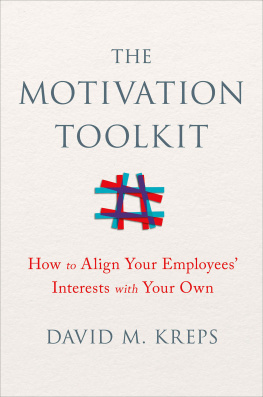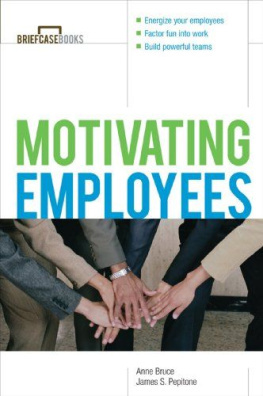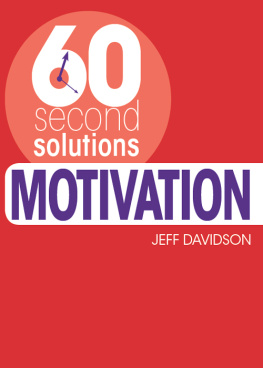
DAVID M. KREPS
The
Motivation
Toolkit
HOW TO ALIGN YOUR
EMPLOYEES INTERESTS
WITH YOUR OWN

Names and identifying details of some companies and events portrayed in this book have been changed.
Copyright 2018 by David M. Kreps
All rights reserved
First Edition
For information about permission to reproduce selections from this book, write to Permissions, W. W. Norton & Company, Inc., 500 Fifth Avenue, New York, NY 10110
For information about special discounts for bulk purchases,
please contact W. W. Norton Special Sales at
specialsales@wwnorton.com or 800-233-4830
Book design by Ellen Cipriano
Production manager: Julia Druskin
Jacket design by Jason Heuer
Jacket photograph by YamabikaY / Shutterstock
ISBN: 978-0-393-25409-9
ISBN: 978-0-393-25410-5 (e-book)
W. W. Norton & Company, Inc., 500 Fifth Avenue, New York, N.Y. 10110
www.wwnorton.com
W. W. Norton & Company Ltd., 15 Carlisle Street, London W1D 3BS
CONTENTS
I would like to acknowledge and thank a number of people, both groups and individuals, for their contributions to this book.
James Baron is first and foremost. It would not be at all inaccurate to describe this book as the Classics Illustrated version of the textbook, Strategic Human Resources: Frameworks for General Managers , that I wrote with Jim. People are complex animals, so managing them is complex, and if the reader finds the content of this book to be of interest and of use, I cannot too strongly recommend the longer, more detailed, and more nuanced textbook. But, beyond this, Jim taught me a lot of whatever wisdom this book contains, and Im grateful to him for that and for our friendship.
Other colleagues, both economists but especially members of Stanford Graduate School of Business (Stanford GSB) faculty who are not economists, have been generous with their time and insights as I put this book together. In alphabetical order, I am grateful in particular to Jennifer Aaker, William Barnett, Glenn Carroll, Francis Flynn, Robert Gibbons, Deborah Gruenfeld, Michael Hannan, Tamar Kreps, David Larcker, Edward Lazear, Neil Malhotra, James March, William Meehan, Dale Miller, Benoit Monin, Charles OReilly, Paul Oyer, Jeffrey Pfeffer, Hayagreeva Rao, Peter Reiss, Kathryn Shaw, Jesper Sorensen, Larissa Tiedens, and Mark Wolfson. (I apologize for any inadvertent omissions.)
This book is, of course, about management, and I learned a lot about management in general, managing human resources, and motivation, by working for and with a master of these crafts, Robert Joss.
Generations of MBA students and Stanford Executive Program participants learned this material along with me and, in so doing, taught me a lot.
Many people at W. W. Norton contributed to the construction of this book, perhaps too many to cite by name. But, in particular, Jeff Shreve picked up this project in midstream and made many important contributions to the organization and exposition of the book. And when Jeff left Norton near the completion of the book, Brendan Curry and Nathaniel Dennett, together with production manager Julia Druskin, did an excellent job in shepherding the book to the end.
Finally, I was encouraged to begin and, every step along the way, to continue working on this book by Jack Repcheck, who previously had edited two textbooks on economics that I wrote. Jacks untimely death prevented him from seeing this book to completion, but both as friend and editor, his imprint is found everywhere within these pages. It is with profound sadness for his passing but with wonderful memories of him that I dedicate this book to his memory.
The
Motivation
Toolkit
T his book addresses the question, How should an organization whether a for-profit start-up, a large corporation, or a not-for-profit motivate the people who work for it, to get the best possible results? Getting motivational practices right is certainly not the only thing you must do to be successful as a manager. But it is crucial to achieving success.
Motivating employees is simultaneously becoming more difficult and more important, as economic activity shifts from the so-called old economy to the new. In a larger and larger share of the economy, organizations need employees who work with their heads as well as their hands, who think and act creatively, whose job involves self-starting and self-monitoring. Monitoring employees to ensure that they do a specific and well-defined task is often infeasible or, when feasible, terribly expensive. And it is often ineffective. Rewarding employees piece-rate styletrying to motivate them to perform that specific task more often and more quicklyworks well in some cases. But pay for performance fails dramatically in other cases. When it isnt clear a priori what employees ought to be doing, when creativity and proaction are desirable, and when employees are expected to allocate their time among several tasks in response to information they see and the employer does not, then motivating employees to do the right thing is difficult and, at the same time, hugely important to organizational success.
And, in many cases, motivation isnt a matter of you (the employer) actively motivating your employees. Instead, you motivate employees most effectively by eliminating demotivating factors.
You can find all sorts of simple answers to the question, How should you motivate employees? A Google search of the phrase motivating employees yields 17 million results. Lots of management gurus know the answer and are happy to share with you what they know. Unhappily, if you read through a selection of these answers, you probably come away more confused than when you began, because what one guru knows to be true, another knows is simple nonsense.
The problem is that there is no single best answer to the question. The best answer for you, in your specific situation, will depend on all sorts of factors that bear on your specific situation. Indeed, it can be a bad idea to look for the best answer , because motivation is but one of a larger set of human resource management (HRM) issues, all of which tie together in complex ways. The very best way to motivate your employees may have adverse and unanticipated consequences on other HRM issues, such as recruitment, or training, or striking the right balance between insourcing and outsourcing. What you should look for instead is a really good answer or, if the potential effects of your motivational strategy on other aspects of HRM are severe enough, a good-enough answer.
To give you a taste of the complexities of motivation and an example of such unanticipated consequences, consider the following parable drawn from real life. (In this story, and in the story of Zephyr Corporation and their employees in concerning Safelite, I invent numbers to simplify the exposition.)
The Sad Story of Artisans Alliance
The Artisans Alliance (AA) was formed by a visionary and socially minded group of entrepreneurs, who wished to help third-world artisans bring their merchandise to first-world markets. The business plan was simple: AA employed young men and women to go into underdeveloped countries, looking for artisans and craftspeople of exceptional skill and talent. When such an artisan was discovered, the employee of AA would offer a partnership, providing technical assistance in arranging to export the artisans wares to first-world countries, where AA would act as intermediary in placing the wares in small, high-end retail stores. The young men and women who traveled the globecalled Explorers by AAwere expected to provide to their client-artisans assistance in logistics and in growing their local shops to the extent feasible while maintaining quality. The Explorers were the key to the operation. Their consummate effort in locating and then supporting exceptional artisans, while building close personal relations with their artisans, provided AA with an expanding supply of outstanding goods. Successful Explorers had very marketable language and interpersonal skills. AA paid Explorers less than they could have made working for larger organizations but, for the most part, the Explorers stuck with AA and provided truly outstanding effort.
Next page






![Jay Kreps - I [heart symbol] logs: event data, stream processing, and data integration](/uploads/posts/book/193914/thumbs/jay-kreps-i-heart-symbol-logs-event-data.jpg)



